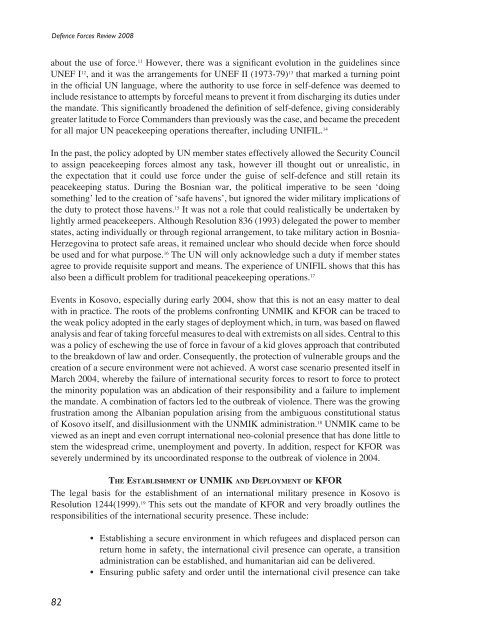Defence Forces Review 2008
Defence Forces Review 2008
Defence Forces Review 2008
Create successful ePaper yourself
Turn your PDF publications into a flip-book with our unique Google optimized e-Paper software.
<strong>Defence</strong> <strong>Forces</strong> <strong>Review</strong> <strong>2008</strong><br />
about the use of force. 11 However, there was a significant evolution in the guidelines since<br />
UNEF I 12 , and it was the arrangements for UNEF II (1973-79) 13 that marked a turning point<br />
in the official UN language, where the authority to use force in self-defence was deemed to<br />
include resistance to attempts by forceful means to prevent it from discharging its duties under<br />
the mandate. This significantly broadened the definition of self-defence, giving considerably<br />
greater latitude to Force Commanders than previously was the case, and became the precedent<br />
for all major UN peacekeeping operations thereafter, including UNIFIL. 14<br />
In the past, the policy adopted by UN member states effectively allowed the Security Council<br />
to assign peacekeeping forces almost any task, however ill thought out or unrealistic, in<br />
the expectation that it could use force under the guise of self-defence and still retain its<br />
peacekeeping status. During the Bosnian war, the political imperative to be seen ‘doing<br />
something’ led to the creation of ‘safe havens’, but ignored the wider military implications of<br />
the duty to protect those havens. 15 It was not a role that could realistically be undertaken by<br />
lightly armed peacekeepers. Although Resolution 836 (1993) delegated the power to member<br />
states, acting individually or through regional arrangement, to take military action in Bosnia-<br />
Herzegovina to protect safe areas, it remained unclear who should decide when force should<br />
be used and for what purpose. 16 The UN will only acknowledge such a duty if member states<br />
agree to provide requisite support and means. The experience of UNIFIL shows that this has<br />
also been a difficult problem for traditional peacekeeping operations. 17<br />
Events in Kosovo, especially during early 2004, show that this is not an easy matter to deal<br />
with in practice. The roots of the problems confronting UNMIK and KFOR can be traced to<br />
the weak policy adopted in the early stages of deployment which, in turn, was based on flawed<br />
analysis and fear of taking forceful measures to deal with extremists on all sides. Central to this<br />
was a policy of eschewing the use of force in favour of a kid gloves approach that contributed<br />
to the breakdown of law and order. Consequently, the protection of vulnerable groups and the<br />
creation of a secure environment were not achieved. A worst case scenario presented itself in<br />
March 2004, whereby the failure of international security forces to resort to force to protect<br />
the minority population was an abdication of their responsibility and a failure to implement<br />
the mandate. A combination of factors led to the outbreak of violence. There was the growing<br />
frustration among the Albanian population arising from the ambiguous constitutional status<br />
of Kosovo itself, and disillusionment with the UNMIK administration. 18 UNMIK came to be<br />
viewed as an inept and even corrupt international neo-colonial presence that has done little to<br />
stem the widespread crime, unemployment and poverty. In addition, respect for KFOR was<br />
severely undermined by its uncoordinated response to the outbreak of violence in 2004.<br />
Th e Es t a b l i s h m e n t o f UNMIK a n d De p l o y m e n t o f KFOR<br />
The legal basis for the establishment of an international military presence in Kosovo is<br />
Resolution 1244(1999). 19 This sets out the mandate of KFOR and very broadly outlines the<br />
responsibilities of the international security presence. These include:<br />
• Establishing a secure environment in which refugees and displaced person can<br />
return home in safety, the international civil presence can operate, a transition<br />
administration can be established, and humanitarian aid can be delivered.<br />
• Ensuring public safety and order until the international civil presence can take<br />
82
















